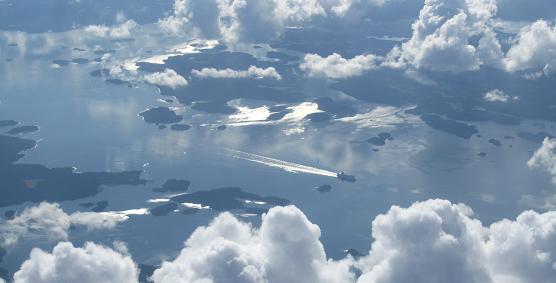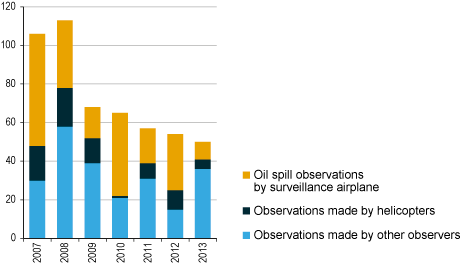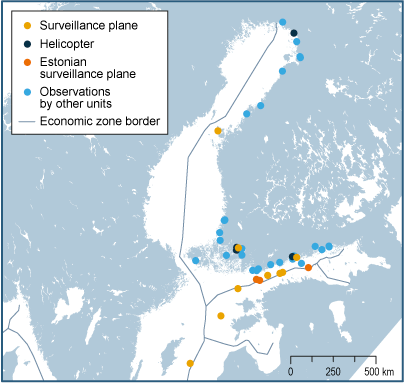Press release 2014-02-11 at 10:57
Press release by SYKE and the Finnish Border Guard
The Finnish Border Guard's surveillance flights discovered only nine illegal oil spills on the Baltic in 2013. The record number of 107 oil spills was reported in 2001. The size of the spills has also decreased markedly. In 2013, the average spill was roughly five litres, compared to 180 in 2001.

Maritime traffic photographed from a surveillance aircraft in August 2013. Photo: SYKE/ Kati Tahvonen
The Baltic Marine Environment Protection Commission (HELCOM) seeks to eliminate illegal oil spills on the Baltic by 2021. The situation is monitored with the help of aerial surveillance statistics compiled by Baltic Sea states. In light of the Finnish statistics for 2013, achieving this target seems possible.
|
Oil spills detected by Finnish surveillance aircraft 1996–2013
|

|
|
Finland also records non-aerial observations
In addition to aerial surveillance, the Finnish Border Guard and rescue services report oil spills in ports or close to shore. The total number of all oil spill observations is also on the decline. In 2013, Finnish authorities discovered 50 oil spills. As a rule, the spills were small in size.
The Finnish Border Guard investigates all oil spills. An oil pollution fee can be imposed on the owner or manager of a vessel guilty of a spill. The Finnish Border Guard may also elect to initiate a pre-trial investigation. In 2013, the Border Guard conducted nine investigations as a result of oil spills.
|
Total oil spill observations on Finnish waters 2006–2013
|

|
|
Total Finnish oil spill observations on the Baltic and Estonian observations made on Finnish waters 2013
|

|
|
International cooperation and surveillance operations
Finnish aircraft conducted approximately 625 hours of aerial surveillance on the Baltic in 2013. The majority of flights took place within Finnish territory, with roughly one quarter of total flight time spent on the territory of other countries. Aircraft from neighbouring countries correspondingly performed 230 hours of aerial surveillance in Finnish territory.
Two of the oil spills discovered by Finnish aircraft were located in the territory of Estonia and one in Swedish territory. Estonian surveillance flights observed three oil spills on Finnish waters.
In 2013, Finnish authorities also participated in surveillance operations for the enhanced monitoring of oil spills on busy shipping lanes. Two of these operations were conducted on the Baltic and one on the North Sea.
International cross-border cooperation in oil spill surveillance is vital, particularly on the narrow Gulf of Finland, where ships navigate on the border of the Finnish and Estonian economic zones.
Modern surveillance equipment and satellite images
Finnish, Swedish and Estonian surveillance aircraft have all modernised their environmental surveillance equipment in recent years. The updated equipment enables the monitoring of shipping also in poor weather and darkness. A side-looking airborne radar (SLAR) can detect oil spills several dozens of kilometres away from the surveillance plane's route. The aircraft are also equipped with devices for the identification of vessels.
Oil spills are also monitored through the CleanSeaNet satellite image service of the European Maritime Safety Agency (EMSA). In 2013, 215 satellite images were taken in Finnish territory.
Further information
Oil spill monitoring
Senior officer Kati Tahvonen, Finnish Environment Institute SYKE, tel. +358 400 148 754, firstname.surname@ymparisto.fi
Oil spill investigation
Maritime Safety Expert Tom Lundell, Finnish Border Guard, tel. +358 40 521 4685, firstname.surname@raja.fi
Communication Specialist Katri Haatainen, Finnish Environment Institute SYKE, tel. +358 295 251 135, firstname.surname@ymparisto.fi
More